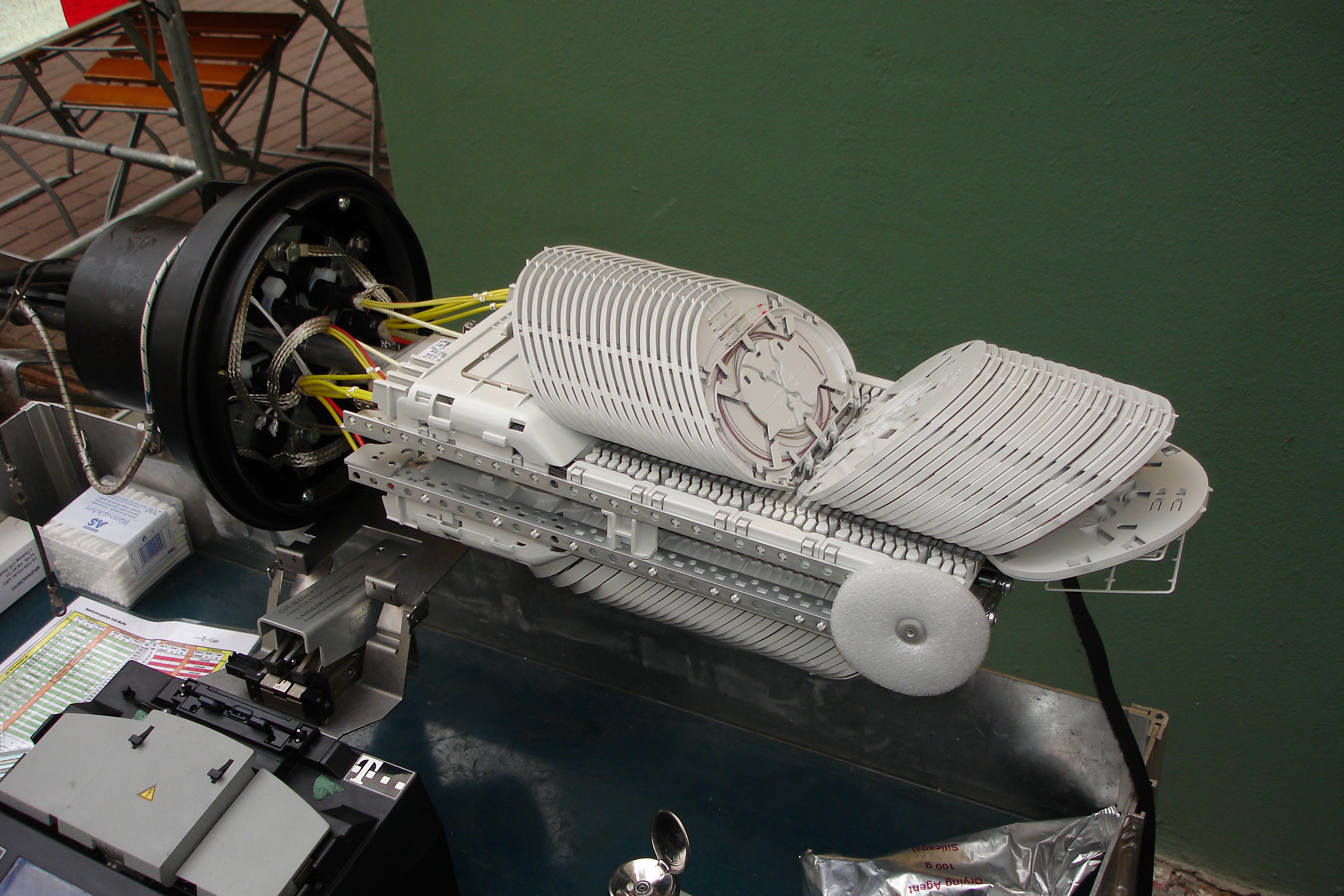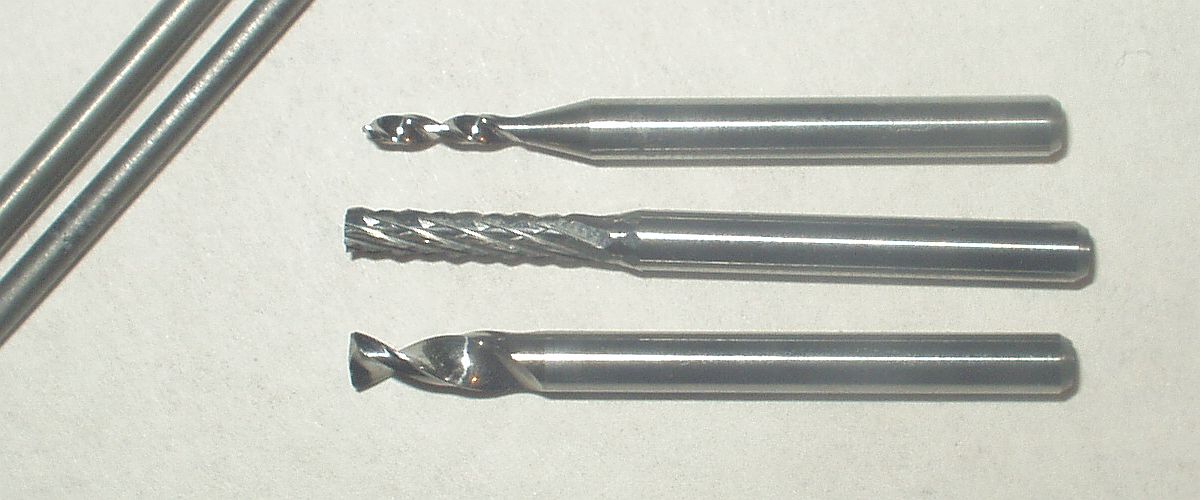|
Cleave (fiber)
A cleave in an optical fiber is a deliberate, controlled break, intended to create a perfectly flat end face perpendicular to the fiber's longitudinal axis. The process of cleaving an optical fiber forms one of the steps in the preparation for a fiber splice operation, regardless of the subsequent splice being a Fusion splicing, fusion splice or a mechanical splice; the other steps in the preparation being those of Stripping (fiber), stripping and fiber alignment. A good cleave is required for a successful low Attenuation, loss splice of an optical fiber, often it is the case that fibers spliced by identical methods tend to have different losses, this difference can often be attributed to the quality of their initial cleaves. The general method of cleaving involves a general strategy known as the scribe-and-tension or scribe-and-break strategy. This strategy involves the introduction of a small crack into the fiber and the subsequent application of a tensile force in the vicinit ... [...More Info...] [...Related Items...] OR: [Wikipedia] [Google] [Baidu] |
Optical Fiber
An optical fiber, or optical fibre, is a flexible glass or plastic fiber that can transmit light from one end to the other. Such fibers find wide usage in fiber-optic communications, where they permit transmission over longer distances and at higher Bandwidth (computing), bandwidths (data transfer rates) than electrical cables. Fibers are used instead of metal wires because signals travel along them with less Attenuation, loss and are immune to electromagnetic interference. Fibers are also used for illumination (lighting), illumination and imaging, and are often wrapped in bundles so they may be used to carry light into, or images out of confined spaces, as in the case of a fiberscope. Specially designed fibers are also used for a variety of other applications, such as fiber optic sensors and fiber lasers. Glass optical fibers are typically made by Drawing (manufacturing), drawing, while plastic fibers can be made either by drawing or by extrusion. Optical fibers typically incl ... [...More Info...] [...Related Items...] OR: [Wikipedia] [Google] [Baidu] |
Fusion Splicing
Fusion splicing is the act of joining two optical fibers end-to-end. The goal is to fuse the two fibers together in such a way that light passing through the fibers is not scattered or reflected back by the splice, and so that the splice and the region surrounding it are almost as strong as the intact fiber. The source of heat used to melt and fuse the two glass fibers being spliced is usually an electric arc, but can also be a laser, a gas flame, or a tungsten filament through which current is passed. Governing standards ANSI/EIA/TIA-455 See also * Fiber-optic communication * Optical fiber connector An optical fiber connector is a device used to link optical fibers, facilitating the efficient transmission of light signals. An optical fiber connector enables quicker connection and disconnection than splicing. They come in various types li ... * Optical time-domain reflectometer References * Further reading * "How to Precision Clean All Fiber Optic Connection ... [...More Info...] [...Related Items...] OR: [Wikipedia] [Google] [Baidu] |
Mechanical Splice
A mechanical splice is a junction of two or more optical fibers that are aligned and held in place by a self-contained assembly (usually the size of a large carpenter's nail). The fibers are not permanently joined, just precisely held together so that light can pass from one to another. This impermanence is an important advantage over fusion splicing, as splice loss, the amount of power that the splice fails to transmit, can be better measured and prevented. Designs and variations There are several designs in use for mechanical splicing, varying based on the method of fiber alignment; four common methods, according to the Fiber Optic Association, are the capillary tube, V-groove, elastometric, and rotary splice. * A capillary tube splice aligns the optical fibers inside of a glass tube, connecting them with a simple adhesive that matches the refractive index of the fibers. This setup allows for manual adjustments and is often a component in the more complex rotary splice. * A V ... [...More Info...] [...Related Items...] OR: [Wikipedia] [Google] [Baidu] |
Stripping (fiber)
Stripping is the act of removing the protective polymer coating around optical fiber in preparation for fusion splicing. The splicing process begins by preparing both fiber ends for fusion, which requires that all protective coating is removed or stripped from the ends of each fiber. Fiber optical stripping can be done using a special stripping and preparation unit that uses hot sulfuric acid or a controlled flow of hot air to remove the coating. There are also mechanical tools used for stripping fiber which are similar to copper wire strippers. Fiber optical stripping and preparation equipment used in fusion splicing is commercially available through a small number of specialized companies, which usually also design machines used for fiber optical recoating. See also *Optical communication Optical communication, also known as optical telecommunication, is communication at a distance using light to carry information. It can be performed visually or by using electronic dev ... [...More Info...] [...Related Items...] OR: [Wikipedia] [Google] [Baidu] |
Fiber Alignment
Fiber (spelled fibre in British English; from ) is a #Natural fibers, natural or Fiber#Artificial fibers, artificial substance that is significantly longer than it is wide. Fibers are often used in the manufacture of other materials. The strongest engineering materials often incorporate fibers, for example Carbon fibers, carbon fiber and ultra-high-molecular-weight polyethylene. Synthetic fibers can often be produced very cheaply and in large amounts compared to natural fibers, but for clothing natural fibers have some benefits, such as comfort, over their synthetic counterparts. Natural fibers Natural fibers develop or occur in the fiber shape, and include those produced by plants, animals, and geological processes. They can be classified according to their origin: * fiber crop, Vegetable fibers are generally based on arrangements of cellulose, often with lignin: examples include cotton, Cannabis sativa, hemp, jute, flax, abaca, piña, ramie, sisal, bagasse, and Ba ... [...More Info...] [...Related Items...] OR: [Wikipedia] [Google] [Baidu] |
Attenuation
In physics, attenuation (in some contexts, extinction) is the gradual loss of flux intensity through a Transmission medium, medium. For instance, dark glasses attenuate sunlight, lead attenuates X-rays, and water and air attenuate both light and sound at variable attenuation rates. Hearing protection device, Hearing protectors help reduce Sound power, acoustic flux from flowing into the ears. This phenomenon is called acoustic attenuation and is measured in decibels (dBs). In electrical engineering and telecommunications, attenuation affects the Wave propagation, propagation of waves and signals in electrical circuits, in optical fibers, and in air. Attenuator (electronics), Electrical attenuators and optical attenuators are commonly manufactured components in this field. Background In many cases, attenuation is an exponential function of the path length through the medium. In optics and in chemical spectroscopy, this is known as the Beer–Lambert law. In engineering, attenu ... [...More Info...] [...Related Items...] OR: [Wikipedia] [Google] [Baidu] |
Scribe Tense-fiber Cleave
A scribe is a person who serves as a professional copyist, especially one who made copies of manuscripts before the invention of Printing press, automatic printing. The work of scribes can involve copying manuscripts and other texts as well as secretarial and administrative duties such as the taking of dictation and keeping of business, judicial, and historical records for kings, nobility, nobles, temples, and City, cities. The profession of scribe first appears in Mesopotamia. Scribes contributed in fundamental ways to ancient and medieval cultures, including Ancient Egyptian literature, Egypt, Chinese culture#Calligraphy, China, Sanskrit#Writing system, India, Persian literature, Persia, the Roman Empire#Literacy, books, and education, Roman Empire, and Illuminated manuscript, medieval Europe. #Judaism, Judaism, Buddhism, and Islamic manuscripts, Islam have important scribal traditions. Scribes have been essential in these cultures for the preservation of legal codes, religiou ... [...More Info...] [...Related Items...] OR: [Wikipedia] [Google] [Baidu] |
Diamond
Diamond is a Allotropes of carbon, solid form of the element carbon with its atoms arranged in a crystal structure called diamond cubic. Diamond is tasteless, odourless, strong, brittle solid, colourless in pure form, a poor conductor of electricity, and insoluble in water. Another solid form of carbon known as graphite is the Chemical stability, chemically stable form of carbon at Standard temperature and pressure, room temperature and pressure, but diamond is metastable and converts to it at a negligible rate under those conditions. Diamond has the highest Scratch hardness, hardness and thermal conductivity of any natural material, properties that are used in major industrial applications such as cutting and polishing tools. Because the arrangement of atoms in diamond is extremely rigid, few types of impurity can contaminate it (two exceptions are boron and nitrogen). Small numbers of lattice defect, defects or impurities (about one per million of lattice atoms) can color ... [...More Info...] [...Related Items...] OR: [Wikipedia] [Google] [Baidu] |
Sapphire
Sapphire is a precious gemstone, a variety of the mineral corundum, consisting of aluminium oxide () with trace amounts of elements such as iron, titanium, cobalt, lead, chromium, vanadium, magnesium, boron, and silicon. The name ''sapphire'' is derived from the Latin word ', itself from the Greek language, Greek word (), which referred to lapis lazuli. It is typically blue, but natural "fancy" sapphires also occur in yellow, purple, orange, and green colors; "parti sapphires" show two or more colors. Red corundum stones also occur, but are called ruby, rubies rather than sapphires. Pink-colored corundum may be classified either as ruby or sapphire depending on the locale. Commonly, natural sapphires are cut and polished into gemstones and worn in jewellery, jewelry. They also may be created synthetically in laboratories for industrial or decorative purposes in large boule (crystal), crystal boules. Because of the remarkable hardness of sapphires 9 on the Mohs scale of miner ... [...More Info...] [...Related Items...] OR: [Wikipedia] [Google] [Baidu] |
Tungsten Carbide
Tungsten carbide (chemical formula: ) is a carbide containing equal parts of tungsten and carbon atoms. In its most basic form, tungsten carbide is a fine gray powder, but it can be pressed and formed into shapes through sintering for use in industrial machinery, engineering facilities, molding blocks, cutting tools, chisels, abrasives, armor-piercing bullets and jewelry. Tungsten carbide is approximately three times as stiff as steel, with a Young's modulus of approximately 530–700 GPa, and is twice as dense as steel. It is comparable with corundum (α- ) in hardness, approaching that of a diamond, and can be polished and finished only with abrasives of superior hardness such as cubic boron nitride and diamond. Tungsten carbide tools can be operated at cutting speeds much higher than high-speed steel (a special steel blend for cutting tools). Tungsten carbide powder was first synthesized by H. Moissan in 1893, and the industrial production of the cemented form starte ... [...More Info...] [...Related Items...] OR: [Wikipedia] [Google] [Baidu] |








